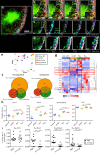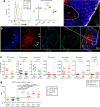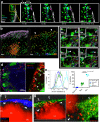Recycling of memory B cells between germinal center and lymph node subcapsular sinus supports affinity maturation to antigenic drift
- PMID: 35513371
- PMCID: PMC9072412
- DOI: 10.1038/s41467-022-29978-y
Recycling of memory B cells between germinal center and lymph node subcapsular sinus supports affinity maturation to antigenic drift
Abstract
Infection or vaccination leads to the development of germinal centers (GC) where B cells evolve high affinity antigen receptors, eventually producing antibody-forming plasma cells or memory B cells. Here we follow the migratory pathways of B cells emerging from germinal centers (BEM) and find that many BEM cells migrate into the lymph node subcapsular sinus (SCS) guided by sphingosine-1-phosphate (S1P). From the SCS, BEM cells may exit the lymph node to enter distant tissues, while some BEM cells interact with and take up antigen from SCS macrophages, followed by CCL21-guided return towards the GC. Disruption of local CCL21 gradients inhibits the recycling of BEM cells and results in less efficient adaption to antigenic variation. Our findings thus suggest that the recycling of antigen variant-specific BEM cells and transport of antigen back to GC may support affinity maturation to antigenic drift.
© 2022. The Author(s).
Conflict of interest statement
The authors declare no competing interests.
Figures






References
Publication types
MeSH terms
Grants and funding
- FC001194 /MRC_/Medical Research Council/United Kingdom
- RP-2017-08-ST2-002/DH_/Department of Health/United Kingdom
- 200817/Z/16/Z/WT_/Wellcome Trust/United Kingdom
- 21777/VAC_/Versus Arthritis/United Kingdom
- MR/P001874/1/MRC_/Medical Research Council/United Kingdom
- FC001194/CRUK_/Cancer Research UK/United Kingdom
- BB/M025292/1/BB_/Biotechnology and Biological Sciences Research Council/United Kingdom
- BB/S003800/1/BB_/Biotechnology and Biological Sciences Research Council/United Kingdom
- MR/N024907/1/MRC_/Medical Research Council/United Kingdom
- 104384/Z/14/Z/WT_/Wellcome Trust/United Kingdom
- FC001194/WT_/Wellcome Trust/United Kingdom
LinkOut - more resources
Full Text Sources
Molecular Biology Databases
Miscellaneous

